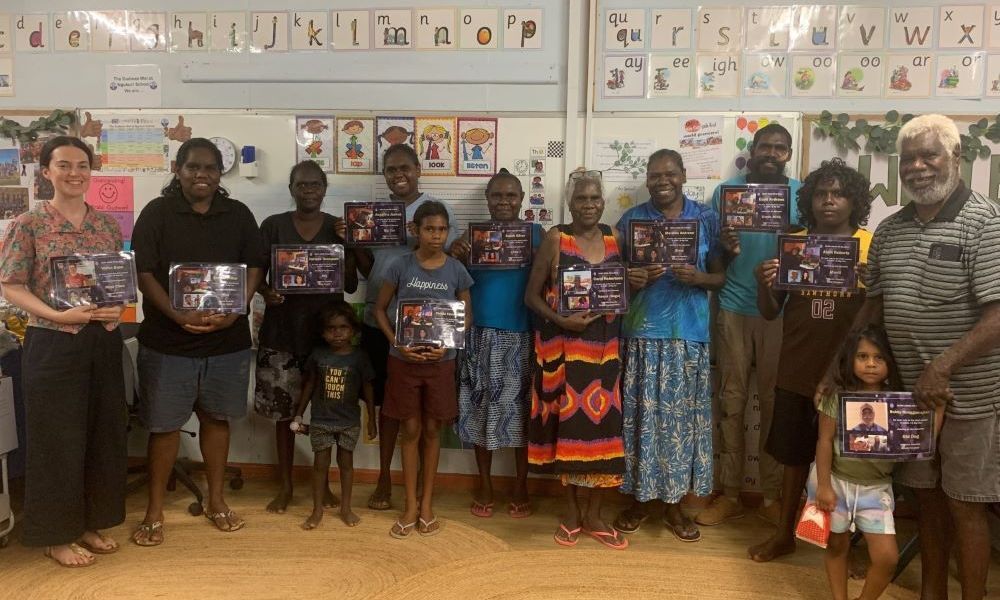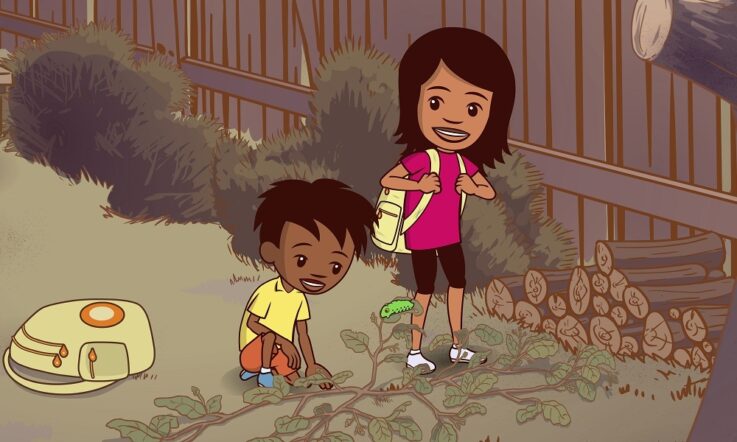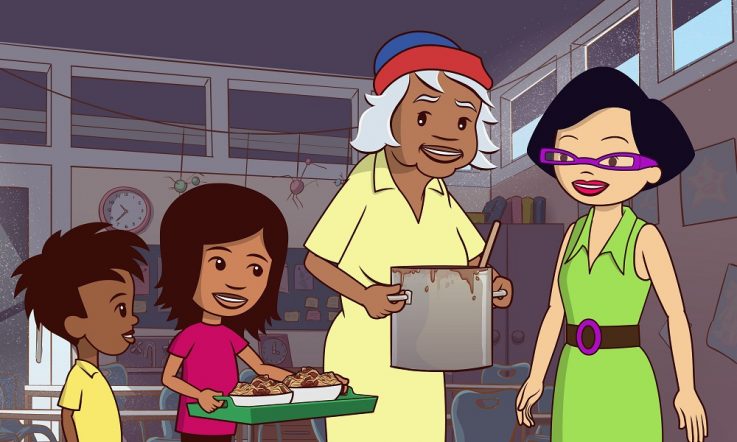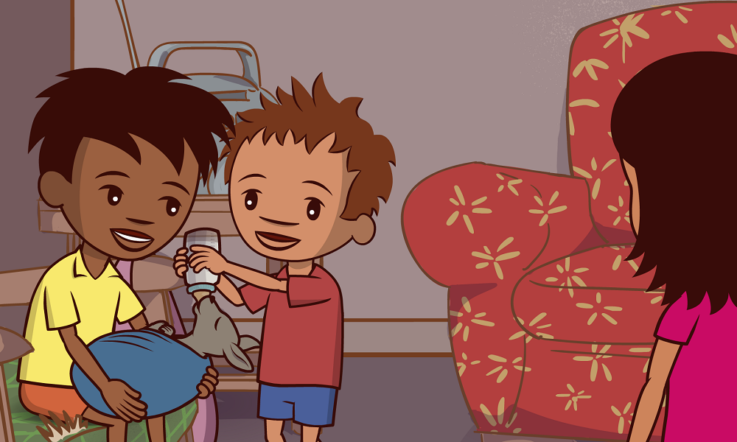Students from the Northern Territory have translated episodes of the animated series Little J & Big Cuz for a real-world school education project – giving them the opportunity to develop and showcase their literacy skills in their first language.
The award-winning show follows the adventures of two Aboriginal children at school, in their community and on country. In the first two seasons, episodes were translated from English into eleven Indigenous languages including Arrernte, Warlpiri, Djambarrpuyngu and Pitjantjatjara.
Season three – released late 2021 – features the very first Kriol episodes, following translation by students at Ngukurr School, in the Katherine Region, as part of a real-world education project. Upper primary and secondary students worked on the translating the English scripts with Greg Dickson, manager of Meigim Kriol Stongbala (Making Kriol Strong), a program administered by Yugul Mangi Development Aboriginal Corporation.
‘In that area, Kriol is such a widely used language but really there was nothing out there for that language or for speakers,’ Dickson tells Teacher.
He explains that it’s important for kids to ‘have literacy skills in their first language and have more awareness of how their first language works,’ and that education has a role to play in achieving this.
‘I was already working a lot with the school, doing different activities in different classes and helping kids learn how to read and write Kriol as well as use Kriol in other ways in their education,’ Dickson says, ‘…helping the school to include Kriol in their local curriculum a bit more.’
How the project worked
Ngukurr School and Dickson selected 12 students to work together to translate two episodes – around 300 lines of dialogue – into Kriol. Sessions were timetabled into the school day, for an hour each Tuesday and Wednesday over two months.
‘The principal was fantastic and just fully supported it,’ says Dickson.
‘I’d knock on everyone’s door and say “are these students here? Can they come to our cartoon translation session?” We had the big screen, and we had the classroom teacher or assistant teacher there helping us as well. Each kid had their English script, their workbook, and their little Kriol alphabet chart to help with their spelling, and we’d just go through line by line.’
A student perspective
He explains that students working on the project brought their own perspective to the translations by putting themselves in the shoes of the characters and imagining how they would speak.
‘We’d say “well, if you’re in that situation, what would you be saying to that person in your own language?” Because if we just had adults doing the translation, we could have done it a lot more easily and quickly, but you wouldn’t have captured that authentic way that kids talk to each other.’
Angelina Joshua, Kriol voice actor for the character Big Cuz, tells Teacher she was ‘proud’ of the Kriol episodes, and that she enjoyed the authenticity of the students’ translations.
‘We speak slightly different Kriol here [in Ngukurr] – from the old people to the young, the teenagers to the little kids, it’s a slightly different dialect. So reading that Kriol was marvellous,’ she says.
‘When I read their translations, it was like being a little kid again. I felt like a little kid. It was just so great!’
The impact on the school and community
After the launch of the new episodes, all the teachers were given copies to show in class, which were watched many times in the last week of the school year.
‘The school could see that the kids were engaging really well with the Kriol programs we were running… and it made school very part of the local context,’ Dickson explains.
He notes that having resources like books and cartoons can help Kriol speakers to ‘feel good about the language they speak,’ and to raise the prestige, status and appreciation of Kriol.
Joshua also reflects on the pride of her family as they watched the Kriol episodes. ‘They feel so proud of themselves… them speaking Kriol, the slang, and they’re like, “Oh! I talk that way, I say that word!”’
For the students, being able to watch the episodes in their own language not only gave them a sense of pride, but also helped to break down barriers to engaging with the content.
‘I was asking the teachers if there was a difference in how the kids respond to it, because they watch different programs in class all the time,’ Dickson says, ‘and they said the difference mainly is that the kids weren’t switching off while watching Kriol programs.
‘What [the producers] have done by putting the program in all these different Indigenous languages is extraordinary – it’s huge. It’s so impactful. And we’ve seen the impacts just with Kriol speakers.’
Little J & Big Cuz was conceptualised by the ACER Foundation, the charitable arm of the Australian Council for Educational Research (ACER), and Ned Lander Media. Season One was developed in partnership with Ned Lander Media, SNAICC, NITV, Screen Australia, Screen Tasmania, Film Victoria, and the Australian Children's Television Foundation. Season Two was further supported with principal production investment from ACER, Screen Australia, Screen Tasmania, Film Victoria and NITV in association with the ABC.
Season Three of Little J & Big Cuz premiered on National Indigenous Television (NITV) in December, and is available on SBS On Demand in English and multiple Indigenous languages. It’s also available on the ABC Kids app, as well as ABC iview.
Editor's
note: This article was updated on 23/02/22 to provide more information about the Yugul Mangi Development Aboriginal Corporation.
As a principal, how can you incorporate Indigenous language education into your school’s curriculum? Which Indigenous land is your school situated on, what is the language group, and how can you recognise and promote learning with and from community?
With colleagues, discuss how you can bring Indigenous languages into the classroom. Do you use Little J & Big Cuz in the classroom? Get in touch with the Teacher team and let us know.
Visit the Little J & Big Cuz website for educator and parent resources.
Season 1 of Little J & Big Cuz is available on DVD through ACER’s online shop.



